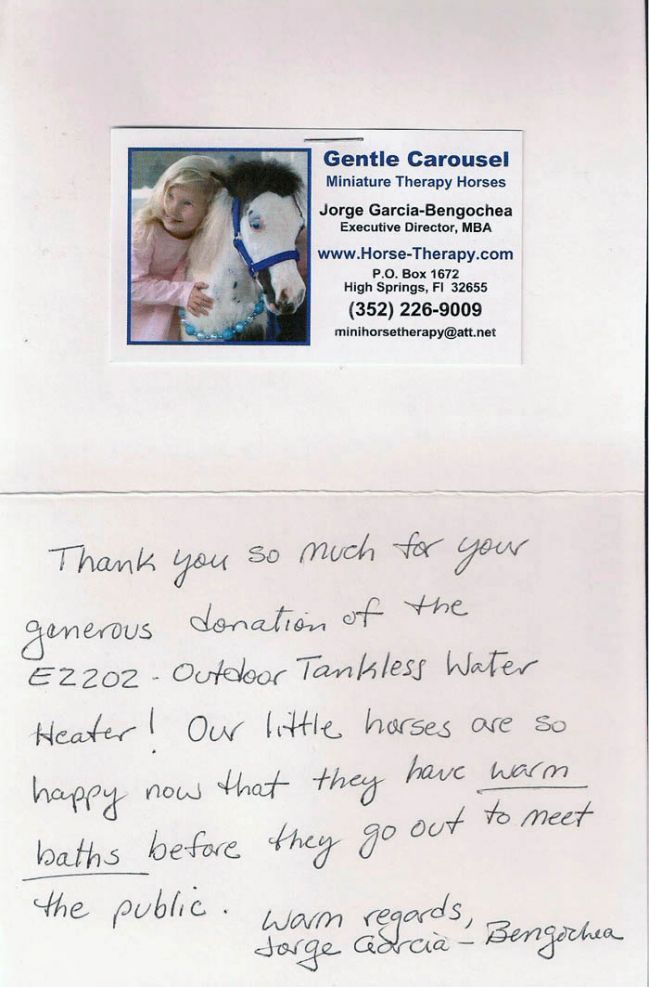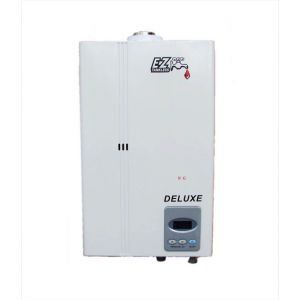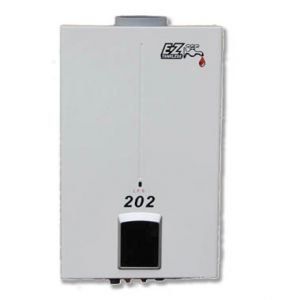Condensing vs. Non-Condensing Tankless Water Heaters
February 10, 2020
To the Point - Traditional tankless water heaters heat the water when called upon as it passes through a burn chamber without utilizing the thermal energy given off by the exhaust gases. Condensing units use that thermal energy of the exhaust gases by passing the water through an initial heat exchanger that houses those exhaust gases before they are pushed outside, thus preheating the inlet water before it enters the main burn chamber. In turn, condensing units operate at a lower BTU, raise the efficiency above 90%, as well as maintain the same gallon per minute when compared to similarly sized units.
Exhaust gases produced by a tankless water heater can reach temperatures upwards of 300°F, which is why traditional units require venting with non-corrosive metals (Category-3 Stainless Steel) to protect from condensation. This can become costly as most tankless water heaters do not come with the venting kit, though all EZ Tankless household water heaters do come with a venting kit. After figuring in the total distance of flue needed, you could be spending an extra $200-$500 after purchasing the unit. The exhaust gases exiting a condensing tankless water heater expel at a much lower temperature, usually around 100°F - 170°F, because most of that thermal energy is used to preheat the inlet water through the initial heat exchanger. Therefore, solid-core schedule 40 PVC/CPVC can be used to exhaust the remaining gases out of the home, which can be half or even a quarter of the cost of using stainless steel.
Not only is venting more cost effective with a condensing tankless water heater, but they’re also more efficient. All condensing tankless water heaters run above 90% efficiency, while non-condensing tankless water heaters usually run in the 80% range.
The cost of condensing units is currently greater than traditional, due to the second heat exchanger that raises the efficiency, but frankly… traditional units are on their way out. They have served us well and will continue to do so in portable and off-grid applications, but there’s no room in the home for them anymore. Condensing units are less expensive to vent, they operate at a lower BTU, and they’re overall more efficient… saving YOU the homeowner more money!
Unlike Europe and Asia, where tankless on-demand waterheaters are common, in the USA storage type units are prevalent. This type of technology is well developed, understood by most homeowners, but really quite wasteful. In today's world more people are making an effort to preserve our natural resources and conserve energy. Conventional tank type heaters are throw way appliances and their carcasses are clogging landfills nationwide.
Unlike Europe and Asia, where tankless on-demand water heaters are common, in the USA storage type units are prevalent. This type of technology is well developed, understood by most homeowners, but really quite wasteful. In today's world more people are making an effort to preserve our natural resources and conserve energy. Conventional tank type heaters are throw way appliances and their carcasses are clogging landfills nationwide. The average American household spends $400 to $600 per year for water heating, making water heating the second highest energy expenditure behind furnace and air conditioner operation. Today, after 100 years without change, North Americans are beginning to accept new water heater technology. The technology that is familiar to families in Europe, Asia, Central and South America seems new to the average American homeowner. In fact, this technology is now considered "mature". In comparison to conventional tank heaters, tankless models differ in the fact that they do not have a large water storage tank. In theory, on demand type instantaneous water heaters should be the best way to go since there is no energy wasted by heating a large tank of water for indefinite periods of time. These models supply instant hot water in a continuous supply as needed. Sensors turn on the instant heater when a hot water tap is opened, and the unit turns off when the faucet or shower head is closed and the flow of hot water stops. Save up to 50% energy usage with a tankless water heater When you talk about going Green and helping the environment why not save a little money in the process. Instant Tankless Water Heaters can save the average American family $108 a year (source: U.S. Department of Energy). Consider that hot water accounts for 30 percent of an average home's energy budget. Tankless water heaters provide an instant continuous flow of hot water as needed by utilizing a heat exchange coil and water flow switch, eliminating the standby energy loss of a conventional storage tank water heater. The U.S. Department of Energy stated that a gas fired tankless water heater is about 23 percent more efficient that a traditional storage version, which is constantly heating your water 24 hours, 7 days a week. This constant heating of water is called standby energy loss.
We are trying to "think green" and many of us are buying products that consume less energy. Are economy automobiles and tankless water heaters similar? The ways in which consumers select them are similar and the answer is often "yes".

Several weeks ago we had the pleasure of talking to a Mr. Jorge Garcia-Bengochea. He came to us asking if we would be able to offer a tankless water heater for use by his charity service - Gentle Carousel. Gentle Carousel brings miniature therapy horses to hospitals, assisted living programs, hospice programs, programs for Alzheimer patients and to adults and children with disabilities so that they may experience a little extra joy in their life. The miniature horses of Gentle Carousel will visit upto 4000 adults and children every year. After hearing of the good work Mr. Garcia-Bengochea is doing, we were glad to offer a helping hand. We sent the Gentle Carousel an EZ 202 for use in their horse washing station. This is the card we received in response.

Every day someone contacts our company asking us for an electric tankless water heater. What we notice is one common misconception. Almost everyone inquiring about an electric tankless heater wants to install it as a replacement for an existing electric tank-type water heater. We have found that most people are visualizing that they simply mount the new electric tankless heater on the wall and plug it into the pre-existing wiring from their old tank type heater. This is simply not a correct assumption. For an electric tankless heater to supply hot water at the required GPM (Gallons Per Minute), a much larger amount of electricity is required. The amount of electricity required is huge when compared to typical appliances. In fact, an electric tankless hot water heater’s electricity requirements exceed the capacity of the typical American home. To find out the details, please read this report and comparison. We have taken the time to explain these energy consumption needs in an easy to understand way. Early in our research, we extensively evaluated electric tankless water heater technology and chose to focus our efforts on gas-fired models. We decided that our company would not enter into the business of electric tankless heaters for a number of reasons. Without turning this article into a sales pitch, we will point out some of the same facts that resulted in our company’s selection of gas fired heaters as our product line. Simply comparing our popular EZ DELUXE 4.0 GPM model to a similar but slightly smaller GPM capacity electric unit, one can clearly see the differences. (To be fair, we compare our EZ Deluxe to one slightly smaller and one slightly larger electric powered unit. The manufacturer’s specifications of the models used in this comparison are listed on their web site and we presume that they are accurate. However, we did not conduct tests on the specific electric models used in this specification comparison.) As previously mentioned, please keep in mind that not everyone lives in a modern newer home, older homes typically do not have 200-AMP and larger electrical services and modern expandable circuit breaker panels. In fact a 300-AMP service is rare in a residential application. Some older homes have only 100-AMP services and in fact some small rural homes may still be operating on 60-AMP services which were typical before the days of central air conditioning and multiple baths.
Recent studies show that 20% of energy consumed in a typical American home is from water heating demand. Switching to a tankless water heating system is proven to provide energy savings, lowering energy bills and reducing your carbon footprint. Many homes demonstrate energy cost savings of $150 per year on average. Proper Installation - We recommend you contact your local licensed plumber who is trained to handle electrical, gas, and plumbing and is aware of all gas fuel codes for a proper installation of the EZ Tankless water heater. Having a non-licensed professional install the unit can cause performance and operational issues. Location of Installation - Install on essentially any wall inside your home with our sleek and modern design. EZ Tankless offers a unit for every location. Venting - EZ Tankless offer the most economical and easiest to install systems on the market and we include the standard intake/exhaust components at no additional charge. Our tankless water heaters can vent vertically through the roof or horizontally through an exterior wall depending on the model. Gas Line Sizes and Fuel Types - EZ Tankless water heaters are designed to provide maximum performance and are available for natural gas or liquid or propane fuel types. The units operate using 1/2" or 3/4" gas line depending on BTU rating. Most of our homes units require 3/4” gas line. When choosing the model that suits your needs the best, ask these questions: Will I run out of hot water? Where can I install my hot water heater? Exterior wall? Interior wall? Central location? Do I have natural gas or propane?
Americans consume, it is what they do! Are American consumers really trying to reduce energy consumption, or is this just another false start like the oil crises' of the 1970s? We have all heard about the "American consumer". Why Americans are called "consumers" is simply because they consume everything they can find, and typically in a very big way. After all, consuming is the "American Way" and this includes oil, electricity, water, and natural gas. Often they consume in ways that are in fact shameful. But Americans don't care, they can consume as much as they want and nobody can do anything about that. It is the right to consume that drives the American economy. Or is it? With the $4.00 per gallon gasoline prices of 2008, Americans were suddenly dumping their big cars and SUVs and in a few months they had purchased millions of little automobiles with small fuel efficient engines. With a typical American knee-jerk reaction to high gasoline prices, Americans are buying these same little cars that people the world over have been using for decades. For more than half a century Europeans and Asians accept these same small cars as they have dense cities with not much available parking space and traditionally pay two or three times as much for gasoline than drivers in the USA. In late 2008 the U.S. Government instituted the "cash for clunkers" bill which paid new car buyers a discount at the dealership up to $4500.00 if they traded-in their gas guzzler for an economy model. This was designed to help the struggling auto industry and reduce the need for imported oil. So, what else is new on the energy saving subject? Tankless water heaters! The typical American will ask; what is a tankless water heater? Another way in which Americans waste energy is the ways in which they heat hot water. As usual, Americans have procrastinated until they are the last culture on earth to change their wasteful ways. Fifty years after Europe began to use tankless hot water heaters this technology has finally entered the minds of some American homeowners. After 100 years without change, Americans are slowly beginning to accept new energy efficient water heater technology. For America, today's flavor of the month is to "go green". This and a substantial tax credit for "green" devices are driving the rapidly expanding USA market for eco-friendly tankless water heaters. The large storage tank type water heater in the typical USA home is a big user of energy. The average American household spends $400 to $600 per year for water heating, making water heating the second highest energy expenditure behind furnace and air conditioner operation. Like the $4.00 per gallon gasoline prices of 2008, it seems that only a slap in the face can awaken the typical American from their wasteful ways. Again the U.S. Government steps in to stimulate (pay) Americans to reduce their energy consumption. This tax credit incentive took effect in February of 2009 and offered a substantial Federal Income tax credit to get the attention of the public and news media alike.
So maybe you have a flex-fuel or Gasoline-Electric hybrid vehicle in your driveway, maybe a compost pile in your back yard? You’ve insulated the house, installed the thermal-pane windows, and may even have a newer energy efficient furnace. Now that you are warm and cozy and “feeling the green” are you still heating a big tank of hot water 24/7/365? If it is a gas tank type heater, did you know that not only are you wasting gas by heating hot water constantly, but you are drawing heat from your home via the draft type exhaust pipe. Maybe you need a tankless hot water heater to complete your green home? “A gas-fired tankless water heater, what is that? Please tell me more?” In Europe and Asia tankless water heaters are the norm. In the United States, homeowners are more familiar with tank storage type water heaters. Today more and more families are making an effort to conserve energy and preserve our natural resources by switching to tankless technology. Primarily, tankless models differ from the typical large cylindrical heaters because they have no storage tank. On demand type, instantaneous tankless water heaters are better as no energy is wasted by pre-heating and holding a large quantity of water in reserve for future use. Tankless heaters produce almost instantaneous hot water in a continuous supply on demand. “How does a tankless heater work?” Sensors inside the heater detect that a hot water tap (faucet or shower) has been turned-on and the heater begins to run, making hot water that exits the heater into the hot water pipes leading to the faucet, sink, or shower. When the faucet or shower is turned off, the heater shuts down and the flow of hot water stops. Modern gas-fired tankless heaters don’t even have a pilot light! They have automatic electronic ignition to save even more energy. “So they save energy. Are they better than a tank-type water heater in other ways?” Tankless heaters can supply a larger total volume of hot water than a tank water heater. The reason is that a tank type heater has only a certain total capacity available. Tank type heaters are sized by their reserve hot water capacity in gallons. Typically only 30, 40 or 50 gallons of water is stored and if you exceed this capacity you must wait for another full tank to heat which can take several hours on some models. With a tankless heater, you have an endless supply of hot water for your needs. The way in which a tankless heater is sized is by its capacity to provide hot water at a specific GPM. In the USA, the volume of water flow is measured in GPM (Gallons per Minute) When a large volume of hot water is needed, more than one tankless heater can be joined together in a group and work in unison. For a tankless heater, the important thing to remember is how to properly size the tankless heater unit to the needs of the household or business in question by calculating your maximum peak GPM needs. “Please tell me more about GPM and how to properly size a tankless heater?” As previously mentioned, tankless water heater manufacturers size their heaters via GPM specifications. Often this is also included with fine print about the temperature rise. If your groundwater temperature is 45 degrees, and the manufacturer advertises that the heater can supply a temperature rise of 60 degrees at 4.0 GPM. What this means is that the output temperature of the water coming from the heater will be 105 degrees at a maximum flow of 4.0 Gallons Per minute. Tank type heaters are sold as total gallons held in reserve in the tank. For example, a typical tank type heater may hold forty gallons of water. Comparing a 4.0 GPM tankless water heater to a forty gallon tank type heater is possible. For example, if a tankless unit produces hot water at 4.0 gallons per minute, this rate of flow will run a 40 gallon tank type heater out of water in only ten minutes. “Please tell me about the latest evolution of tankless water heaters. Because several years ago, I was told they were not very good.” It is a fact that the early models of tankless heaters sold in the USA years ago were small and could not meet the needs of a typical household. (Especially the electric ones.) They were primitive and often broke down. Sometimes the homeowner had to wait for a visit by a qualified technician and then parts were needed and had to be ordered. Because of these experiences of years past, tankless heaters had developed a reputation for malfunctions and an inadequate supply of hot water. Today’s models are designed to last fifteen to twenty-five years, and are much more reliable. If the unit being installed is properly sized to meet the needs of the home or business, and properly maintained, it will supply reliable continuous hot water for many years to come. “Is there a down-side to a tankless water heater?” The biggest enemy of any water heating device is hard or sediment filled incoming water. (For example, as you may have experienced, this is the leading cause of failure in coffee makers) As with any type of water heater, the tankless varieties also work best when used with a water softener or at the very least a filter installed on the incoming water supply. Just like a tank type heater, manufacturers of tankless models recommend diligence in performing periodic flushing and internal cleaning as recommended. The interval period for this maintenance depends on the hardness of the water and the type of filtering and/or treatment being done to the incoming water. Learn more about properly maintaining a tankless water heater. In addition, households with well water will need to address the need for a more constant water pressure. Well pumps cause fluctuations in pressure that can confuse the internal control devices of a modern tankless heater. Find out more about using a tankless water heater with well water. “I have been told that the exhaust for a tankless water heater is special. Is this true?” The exhaust on a tankless heater is much different. Most of today's models use forced-air ventilation or are direct vent. (Direct vent is also known as "balanced" or "dual chamber" exhaust-intake) Because of much higher exhaust temperatures, stainless steel pipe designed for this purpose is always used. This is an important part of any indoor installation and is a requirement of industrial, local and national safety codes. This type of pipe has special sealed joints. This pipe is not the same as normal water heater or furnace exhaust pipe and the components do not interchange. With this type of exhaust the gasses are forced outside under pressure, not by a natural updraft as in a tank type heater. American homeowners are now accepting tankless water heaters as the wave of the future. The average American homeowner is just now finding out about this technology when in fact, people in other countries around the world know of no other way to heat water. “If I buy one now, will it be obsolete in only a few years?” More than ninety percent of the manufacturers of tankless water heaters are based in Asia. These heaters are built in modern new factories operated by companies that have been building millions of tankless heaters for decades. At this time, it is our understanding that there are no gas-fired tankless heaters produced in North America This is not new technology, it seems new to the typical USA homeowner because we are just now becoming aware of how much energy they save. These days, as a society we are beginning to change our wasteful ways and try to save energy. But as a homeowner, we are not only trying to save energy, but to also reduce our energy expenses as well. These new modern direct vent tankless water heaters have evolved to the point where the USA federal government has declared this technology "mature". What this means is that little future change is expected in these devices. They have reached a level of development where they are about as energy efficient as they can be and the design seems to have peaked as well. In fact, generally speaking most direct-vent heaters from all manufacturers are basically the same design. And in fact, some of the big-box home improvement chain stores are selling tankless water heaters under several different brand names that are in fact identical and produced in the same Asian factories. For some popular models, only the labels, brand names, and retail outlets differ.
A brief explanation of soldering pipe for a tankless water heater installation. Jesse Wellenstein was a professional trials bike rider sponsored by EZ Tankless co-founder Jim Snell and his company, Rising Sun Imports, Inc. After winning a couple national championships and still not gaining the popularity one would expect, Jesse retired to plumbing in his home state of Illinois. In this video Jesse demonstrates the proper method for soldering copper pipe pieces together. If you pay enough attention, you can also learn to make a set of your own tankless water heater service valves. -- The EZ Tankless Team Video shot were taken 09-26-2009




